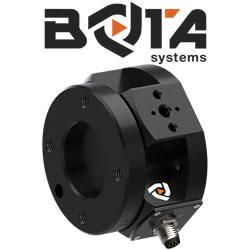Robotic Trends in 2025: Innovations Transforming Industries
The robotics landscape in 2025 is an example of how innovation continues redefining industries. Robotics together with technologies such as Artificial Intelligence or the Digital Twin, acts as a driving force for cost reduction, operational efficiency and competitive positioning. This article delves into the main trends of robotics in 2025, showing its potential to revolutionise various sectors.
1️⃣ARTIFICIAL INTELLIGENCE AND MACHINE LEARNING
🔺Enhanced Autonomy: Robots are performing complex tasks like advanced planning, pattern recognition, and fault prediction.
🔺Real-Time Adaptation: AI enables robots to respond dynamically to environmental changes, enhancing their functionality.
🔺Improved Connectivity: Human-robot interaction is evolving with specialized AI that facilitates seamless communication and task execution.
By leveraging AI, industries can deploy robots that not only perform tasks efficiently but also learn and improve in real time.
2️⃣COLLABORATIVE ROBOTS (COBOTS): REDEFINING WORKFORCE DYNAMICS
Collaborative robots or cobots are valuable because of their ability to interact directly with humans, facilitating their use in small businesses and dynamic environments. Their flexibility, precision and adaptability is transforming work dynamics, reducing costs and increasing efficiency in various industries.
By 2025, these robots are expected to evolve to enhanced capabilities:
🔺Increased autonomy: Integrating more advanced software and sensors, cobots can perform more complex tasks and adapt to changes in real time independently
🔺Ease of use: Simplified programming allows non-experts to operate cobots, expanding their accessibility for small and medium-sized enterprises (SMEs) to have access to these technologies.
🔺Increased safety: technological developments and built-in safety features ensure secure interaction with human operators, even in high-risk environments.
3️⃣MOBILE MANIPULATORS: A GAME-CHANGER IN ROBOTICS
Autonomous Mobile Manipulation will still be one of the most valuable trends in 2025 thanks to the possibilities offered by the combination of a mobile platform and a manipulator arm.
Applications of Mobile Manipulators:
🔺Transporting and handling objects in dynamic industrial environments.
🔺Performing repetitive tasks like assembly, bolting, or packaging.
🔺Improving operational efficiency in industries that require mobility and precision.
🔺With increased adoption across enterprises, mobile manipulators are proving invaluable for enhancing productivity and reducing operational costs.
4️⃣DIGITAL TWIN TECHNOLOGY: OPTIMIZING ROBOTICS THROUGH VIRTUAL SIMULATIONS
Digital Twin technology creates virtual replicas of robotic systems, enabling real-time analysis and optimization without physical risks.
Advantages of Digital Twins in Robotics:
🔺Simulated Testing: Test scenarios virtually to identify potential failures.
🔺Performance Optimization: Analyze and refine robot functionality before deployment.
🔺Maintenance Efficiency: Predict and prevent mechanical failures, reducing downtime.
This technology accelerates innovation while ensuring cost-effective and risk-free development.
5️⃣HUMANOID ROBOTS: THEIR CONTRIBUTION TO SERVICE ROBOTICS
Humanoid robots are becoming increasingly prevalent in sectors such as healthcare, personal assistance, and critical environment exploration.
🔺Improved Mobility: Enhanced dexterity allows humanoids to navigate complex environments.
🔺Versatile Applications: humanoids are already being used in tasks ranging from social and health care to industrial tasks such as the inspection of hazardous areas.
🔺Advancing AI Integration: Customizable AI capabilities make humanoids adaptive to specific needs.
As investments in humanoid robotics grow, their practical applications continue to expand.
6️⃣CUSTOMISATION AND MODULARITY IN ROBOTICS
In 2025, the demand for customized robotic solutions is on the rise. Industries are opting for modular designs to meet specific requirements.
🔺Modular designs: Robots with interchangeable components or modules like RB-THERON that adapt to different tasks according to the user's needs.
🔺Industry-specific solutions: From manufacturing to inspection and maintenance, tailored robots address the unique needs of different sectors.
🔺Adaptable interface: Robots can be easily configured through accessible software platforms such as ROS, in the case of Robotnik.
7️⃣SUSTAINABLE ROBOTICS AND ENERGY EFFICIENCY
Sustainability is a core focus in robotics development for 2025. Robots are now being designed with eco-friendly materials and energy-efficient systems.
🔺Recyclable Materials: Robots constructed with sustainable materials reduce environmental impact.
🔺Energy Optimization: Innovations in battery technology and power management ensure energy efficiency.
🔺Green Manufacturing Practices: Robotics manufacturers are adopting processes that prioritize sustainability.
This trend aligns with the global push towards reducing carbon footprints in technology.
Featured Product

Bota Systems - The SensONE 6-axis force torque sensor for robots
Our Bota Systems force torque sensors, like the SensONE, are designed for collaborative and industrial robots. It enables human machine interaction, provides force, vision and inertia data and offers "plug and work" foll all platforms. The compact design is dustproof and water-resistant. The ISO 9409-1-50-4-M6 mounting flange makes integrating the SensONE sensor with robots extremely easy.
No adapter is needed, only fasteners! The SensONE sensor is a one of its kind product and the best solution for force feedback applications and collaborative robots at its price. The SensONE is available in two communication options and includes software integration with TwinCAT, ROS, LabVIEW and MATLAB®.
